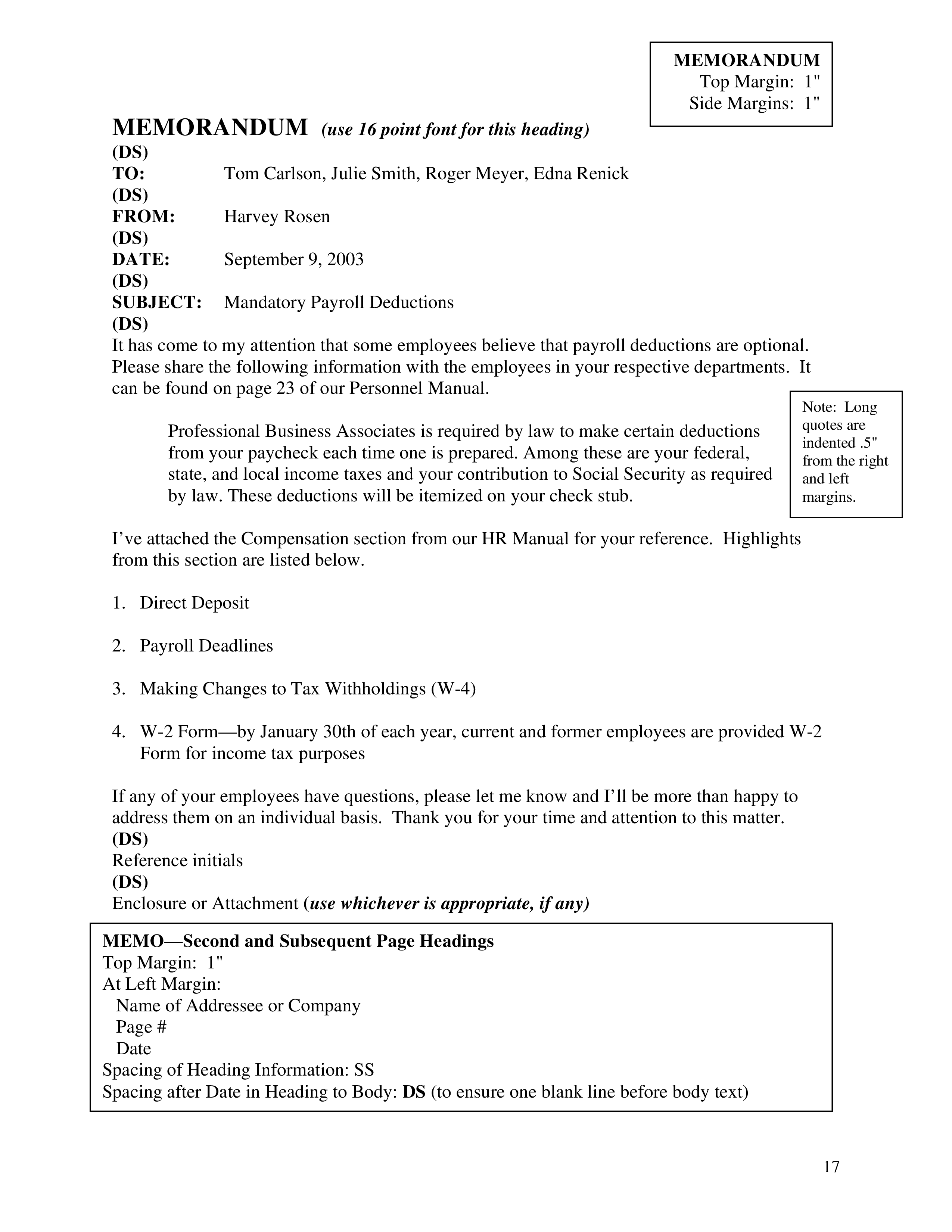Professional Business Associates Memo Format
Save, fill-In The Blanks, Print, Done!

Download Professional Business Associates Memo Format
Adobe Acrobat (.pdf)- This Document Has Been Certified by a Professional
- 100% customizable
- This is a digital download (12.4 kB)
- Language: English
- We recommend downloading this file onto your computer.
Which format is used for a professional memo? Download this professional business associates memo template now!
A Business Associates Memo, often referred to as a memorandum of understanding (MOU) or a business partnership memo, is a formal document that outlines the terms and understanding between two or more parties entering into a business relationship or partnership. When creating this document, it's important to include specific details to ensure clarity and avoid misunderstandings. Here are the key elements to mention in a Business Associates Memo Format:
1. Title: Include a clear and descriptive title at the top of the memo, such as "Business Associates Memo" or "Memorandum of Understanding."
2. Parties Involved: Clearly identify and list the names, legal entities, addresses, and contact information of all parties entering into the agreement. This section should make it unequivocal who the memorandum pertains to.
3. Date: Specify the date on which the memo is created and executed.
4. Purpose and Objectives: State the primary purpose and objectives of the agreement. Explain why the parties are entering into this business relationship or partnership.
5. Terms and Scope: Detail the specific terms, scope, and duration of the business association. Include information such as:
- The start and end dates of the agreement, if applicable.
- The scope of work, services, or products involved.
- Any geographic limitations or exclusivity clauses.
- Key performance indicators (KPIs) or milestones to measure progress.
6. Responsibilities and Obligations: Outline the responsibilities, duties, and obligations of each party involved. Be clear about who is responsible for what, and specify any shared responsibilities or collaborative efforts.
7. Financial Terms: Provide details on financial arrangements, including:
- Payment terms (e.g., payment schedule, method of payment).
- Pricing structures and rates, if applicable.
- Revenue sharing or profit-sharing arrangements, if relevant.
- Any upfront fees, deposits, or financial guarantees.
8. Intellectual Property and Confidentiality:
Address intellectual property rights and confidentiality provisions. Specify how intellectual property (e.g., patents, trademarks, copyrights) will be handled and outline confidentiality obligations to protect sensitive information.
9. Dispute Resolution: Include a section on dispute resolution mechanisms. Outline how disputes will be resolved, whether through negotiation, mediation, arbitration, or legal action.
10. Termination and Exit Strategy: Describe the conditions and procedures for terminating the agreement. Include notice periods, grounds for termination, and any obligations or consequences upon termination.
11. Governing Law and Jurisdiction: Indicate the governing law that will apply to the agreement and specify the jurisdiction where legal disputes will be resolved.
12. Amendments: Explain how the memorandum may be amended in the future, including the process for mutually agreeing on changes.
13. Signatures: Include spaces for the authorized representatives of each party to sign and date the memorandum to indicate their acceptance of the terms.
14. Execution Details: Specify how and when the memorandum will be executed, including any conditions precedent that must be met before the agreement becomes effective.
15. Attachments and Exhibits: If there are any additional documents, exhibits, or schedules related to the agreement (e.g., business plans, financial statements), list them and attach them to the memorandum.
16. Review and Legal Counsel: Encourage all parties to seek legal counsel for review and advice before signing the memorandum to ensure full understanding and compliance with applicable laws and regulations.
By including these essential elements in your Business Associates Memo, you can create a comprehensive and legally binding document that sets clear expectations and terms for your business relationship or partnership.
Top Margin: 1" Side Margins: 1" MEMORANDUM (use 16 point font for this heading) (DS)
TO:
FROM:
DATE: September 9, 2023
SUBJECT: It has come to my attention that some employees believe that payroll deductions are optional..
This Professional Business Associates Memo Format template can help you find inspiration and motivation. This Professional Business Associates Memo Format covers the most important topics that you are looking for and will help you to structure and communicate in a professional manner with those involved. Feel free to download this intuitive template that is available in several kinds of formats, or try any other of our basic or advanced templates, forms or documents. Don't reinvent the wheel if you wan to create a Memo. Check out our memo templates here or check out this Memo template Google Docs here.
Download this Professional Business Associates Memo Format template and save yourself time and effort! You will see completing your task has never been easier to make a memorandum.
DISCLAIMER
Nothing on this site shall be considered legal advice and no attorney-client relationship is established.
Leave a Reply. If you have any questions or remarks, feel free to post them below.
Memo Format
How to format a business memo or legal memo? What is the best way to make a simple memo template? In what format does a memo template appear?
Read moreRelated templates
Latest templates
Latest topics
- GDPR Compliance Templates
What You Need To Be DPR compliant? Are you looking for useful GDPR document templates to make you compliant? All these compliance documents will be available to download instantly... - Google Sheets Templates
How to work with Google Sheets templates? Where to download useful Google Sheets templates? Check out our samples here. - Drop Shipping Agreement
How to start drop shipping? Do you need a Drop shipping Agreement? Check out our Dropshipping Agreement templates now! - Excel Templates
Where to find usefl Excel templates? How do I create a template in Excel? Check these editable and printable Excel Templates and download them directly! - Google Docs Templates
How to create documents in Google Docs? We provide Google Docs compatible template and these are the reasons why it's useful to work with Google Docs...
cheese

